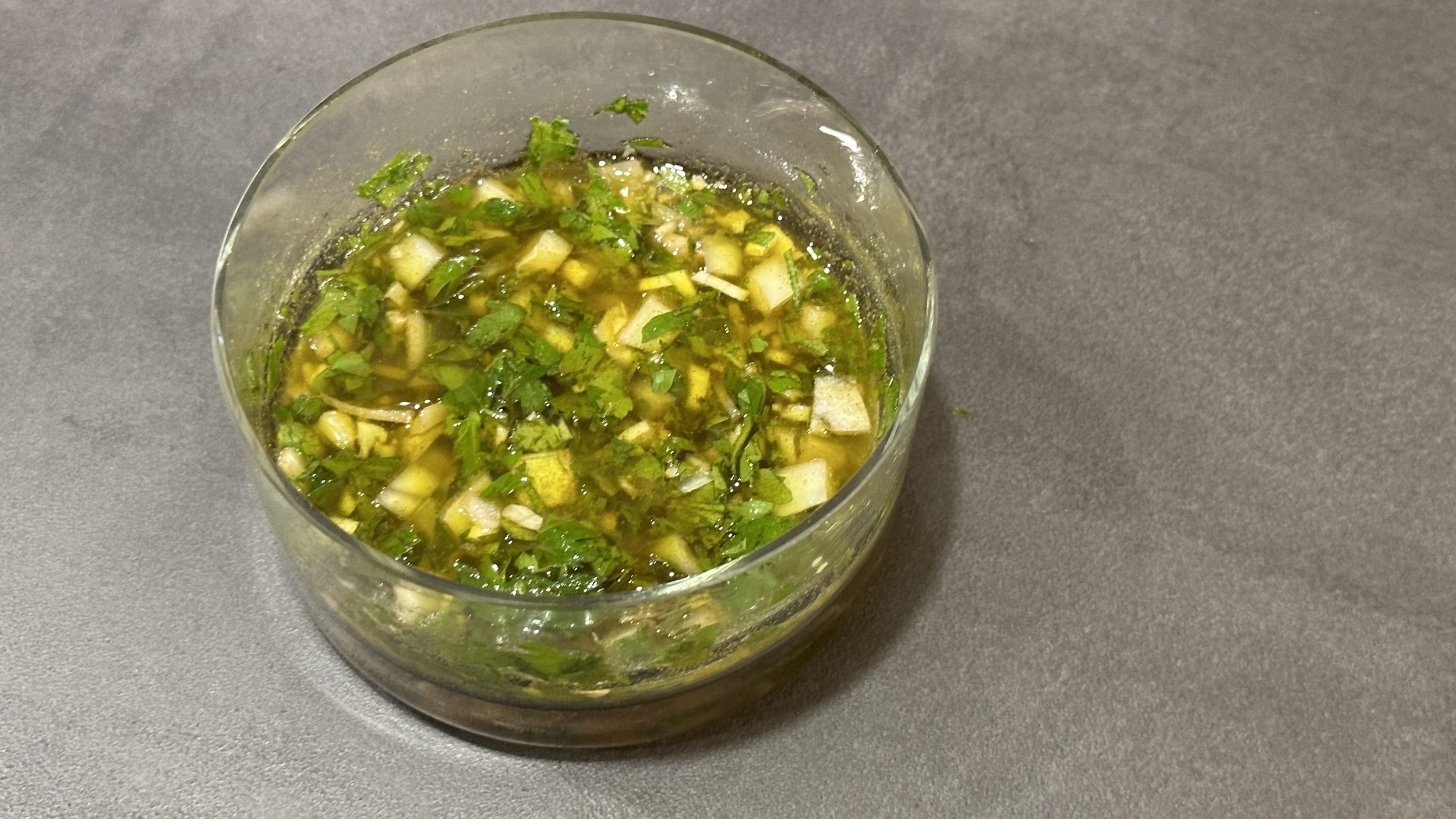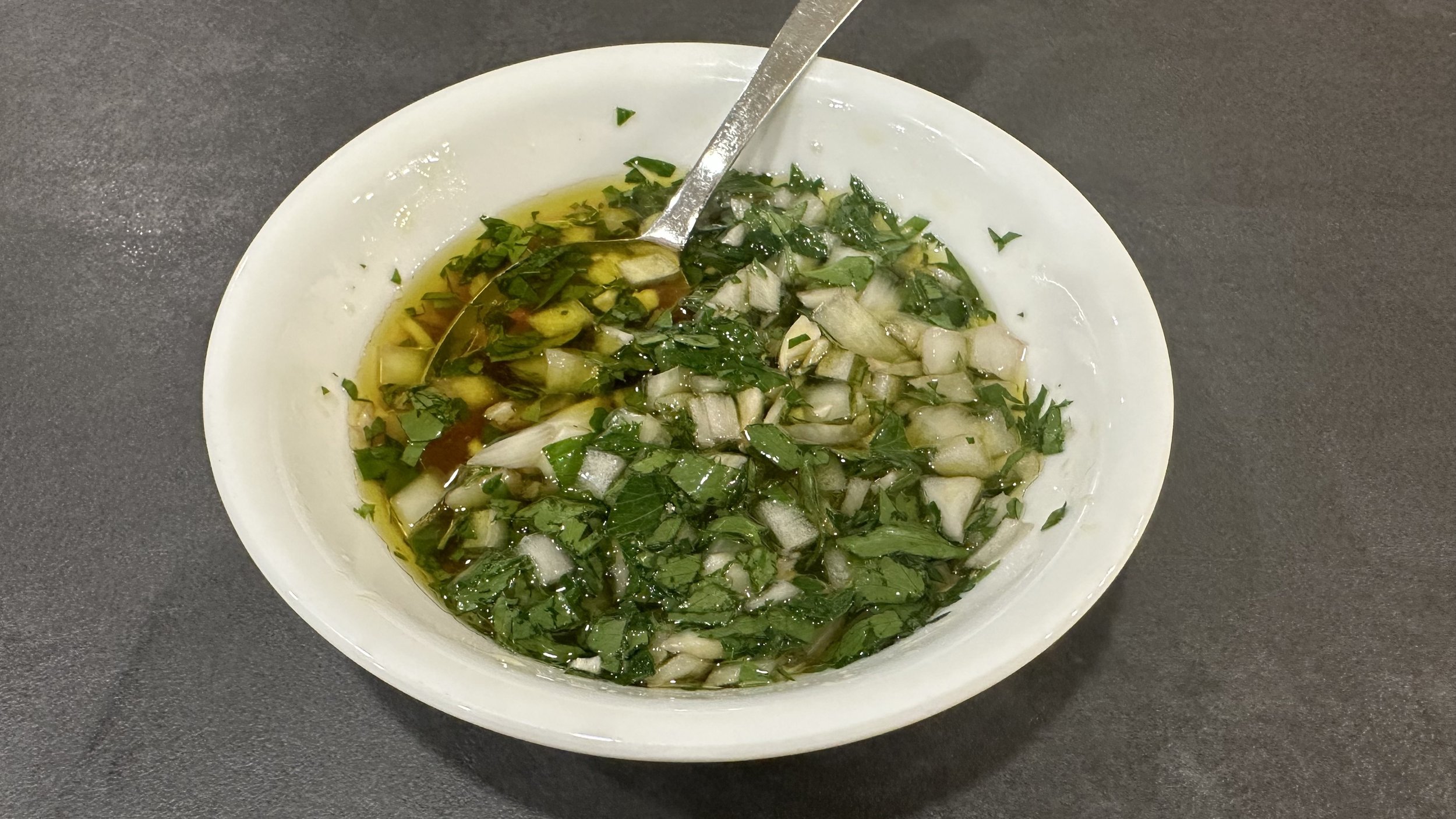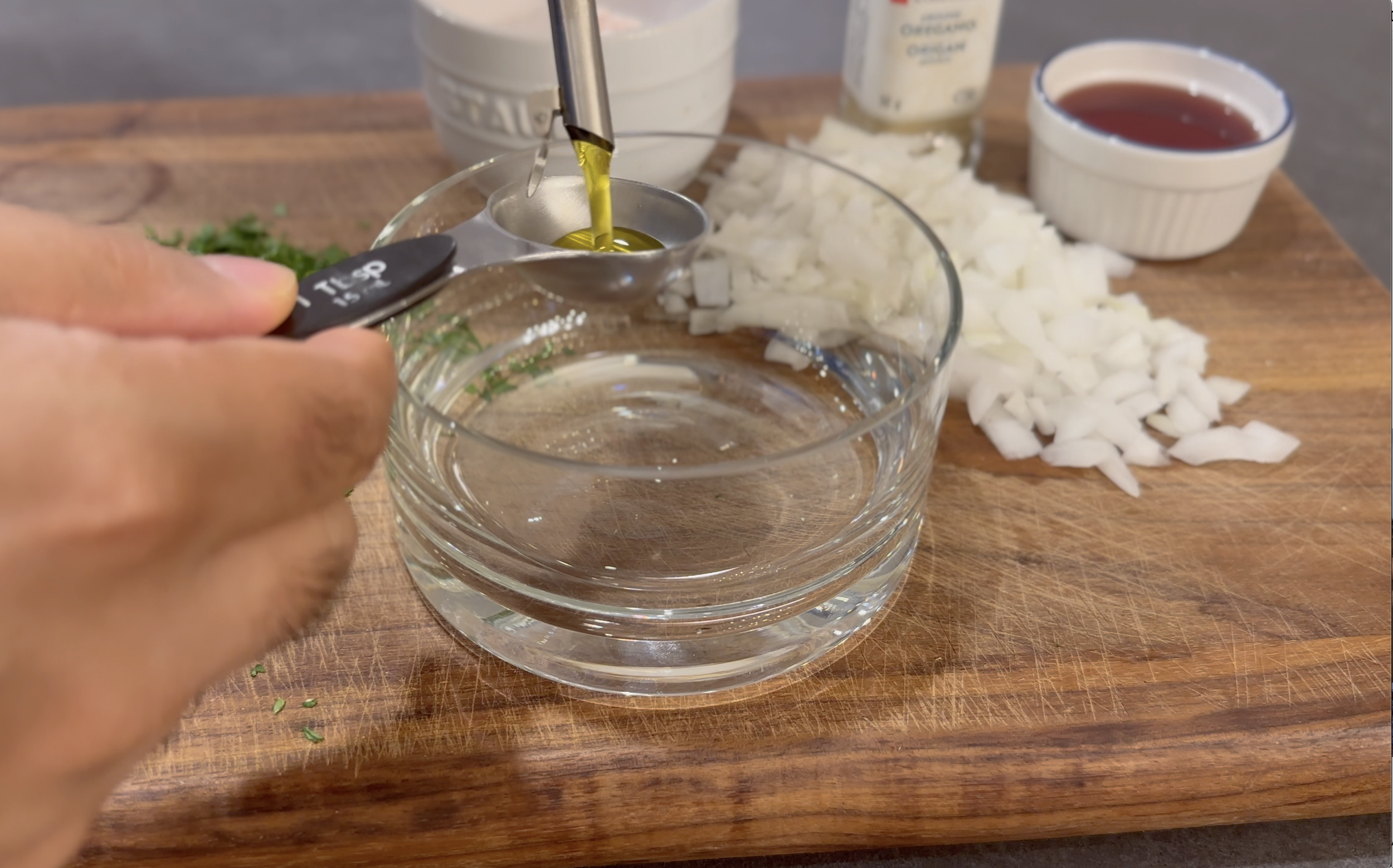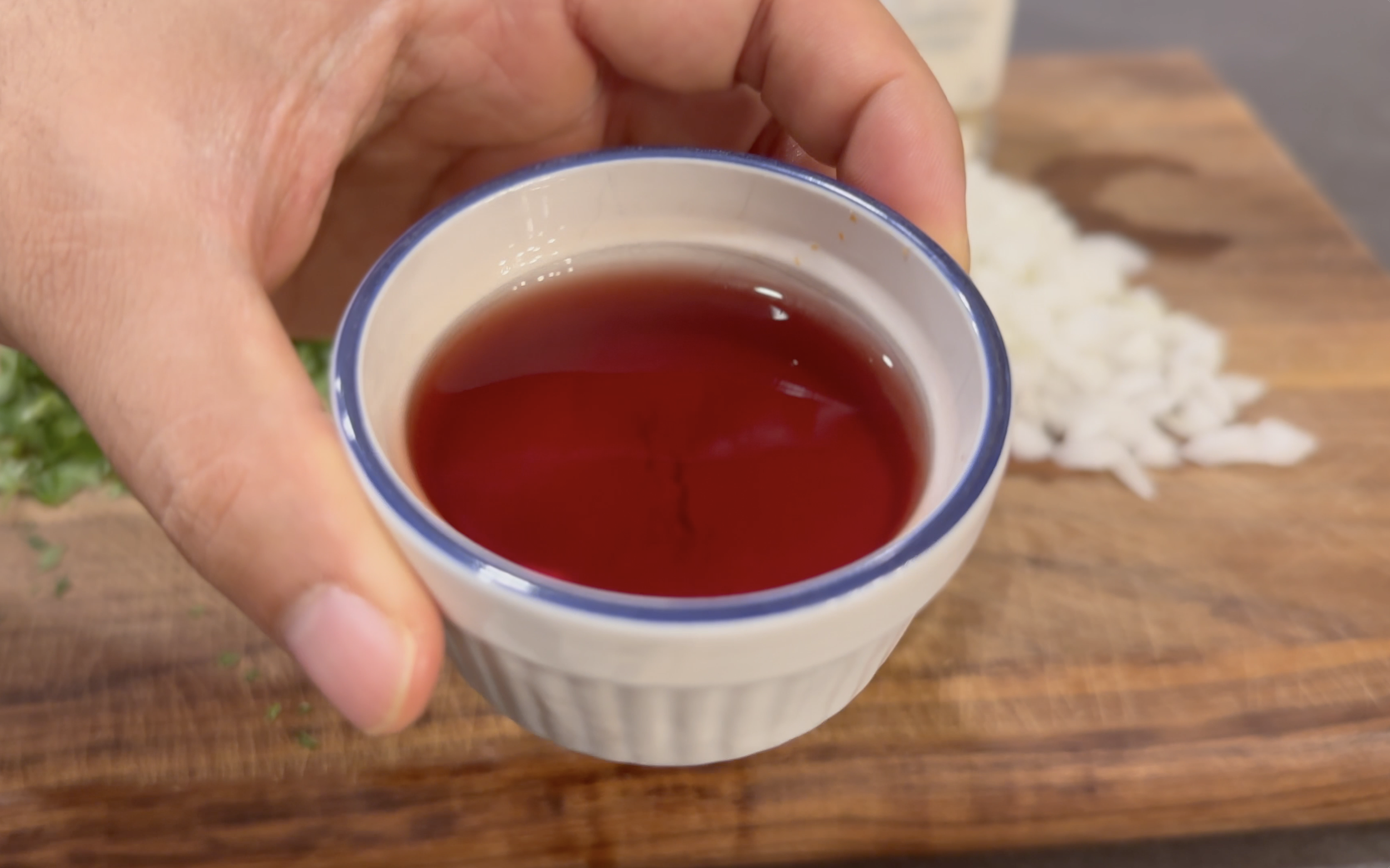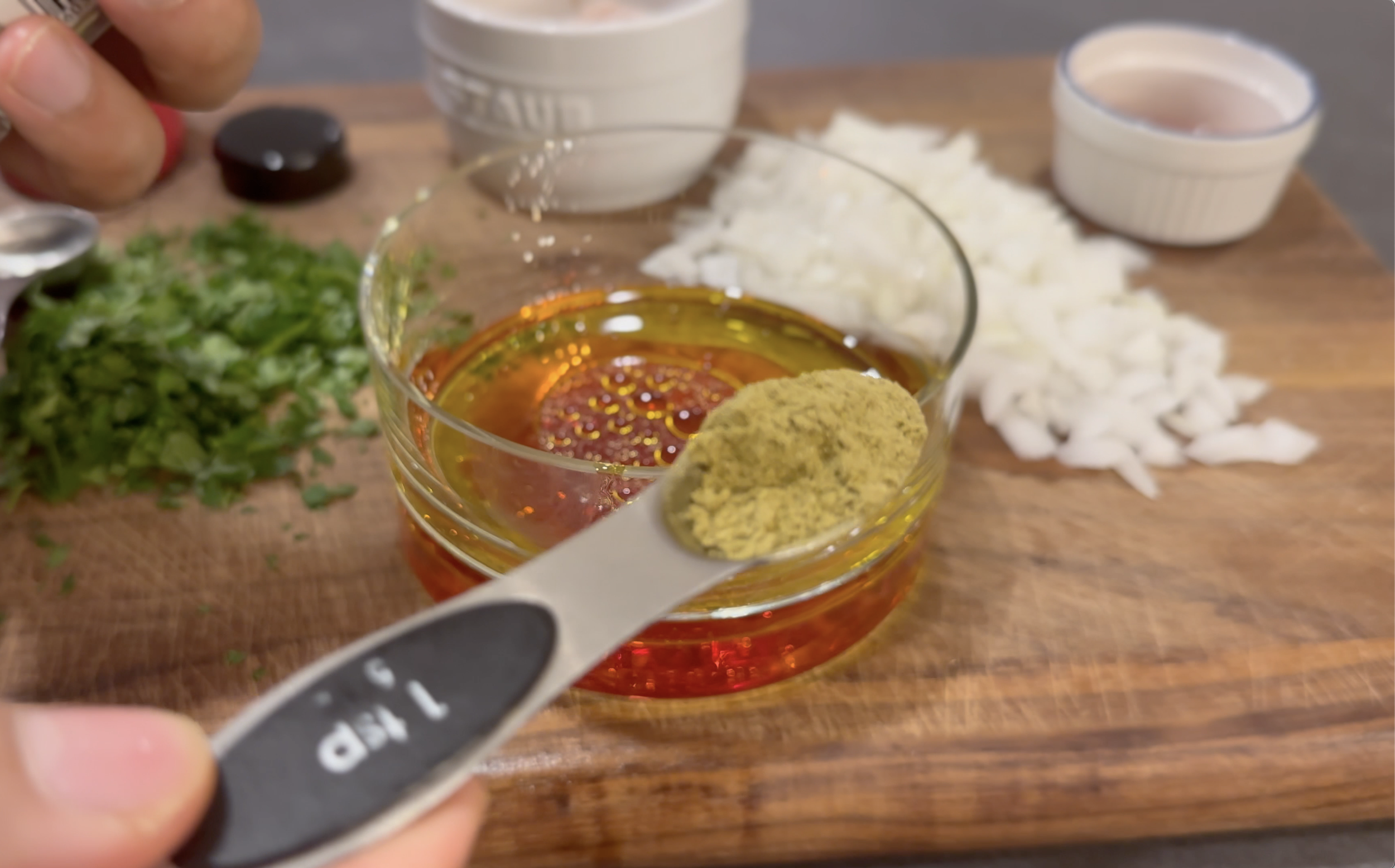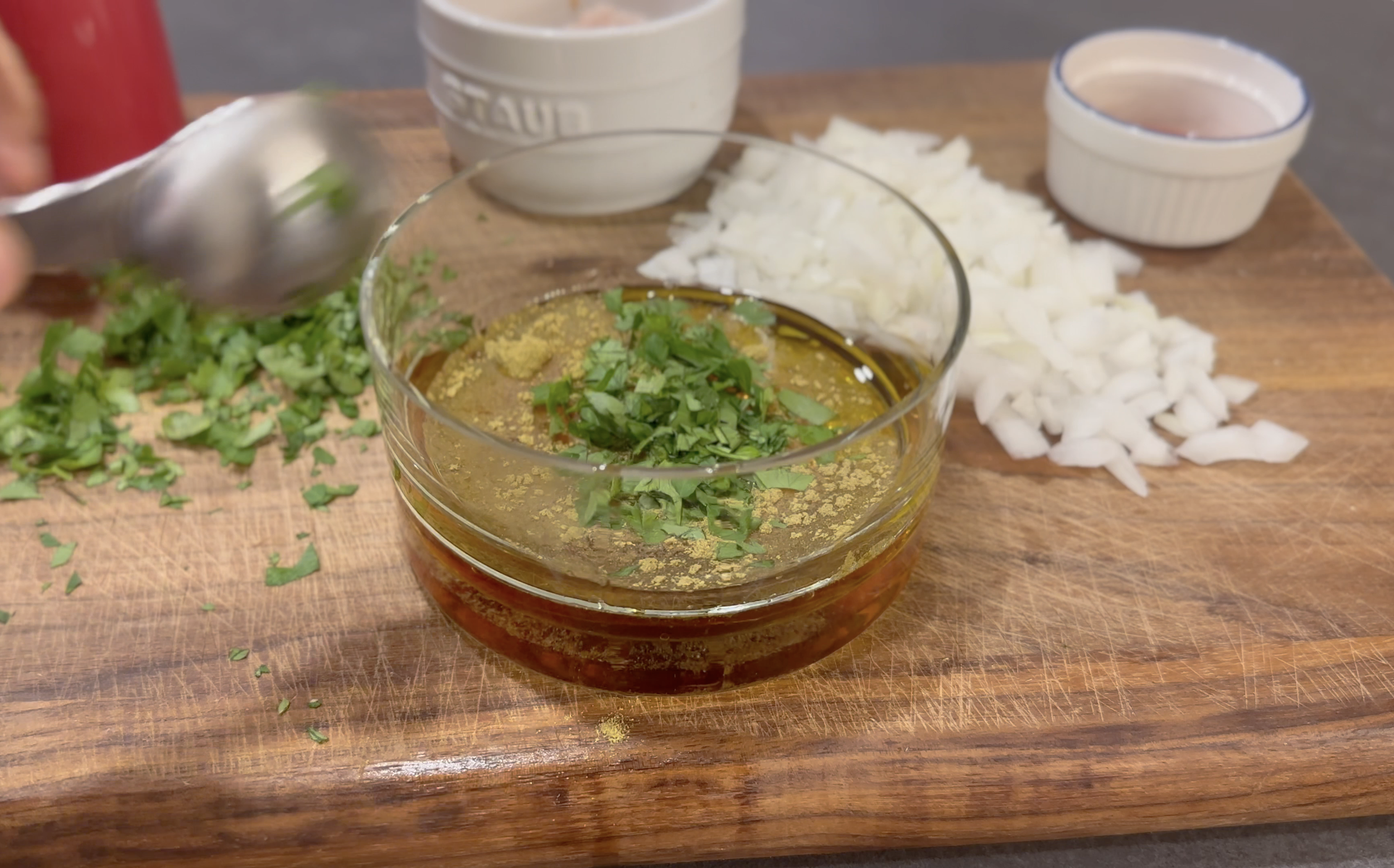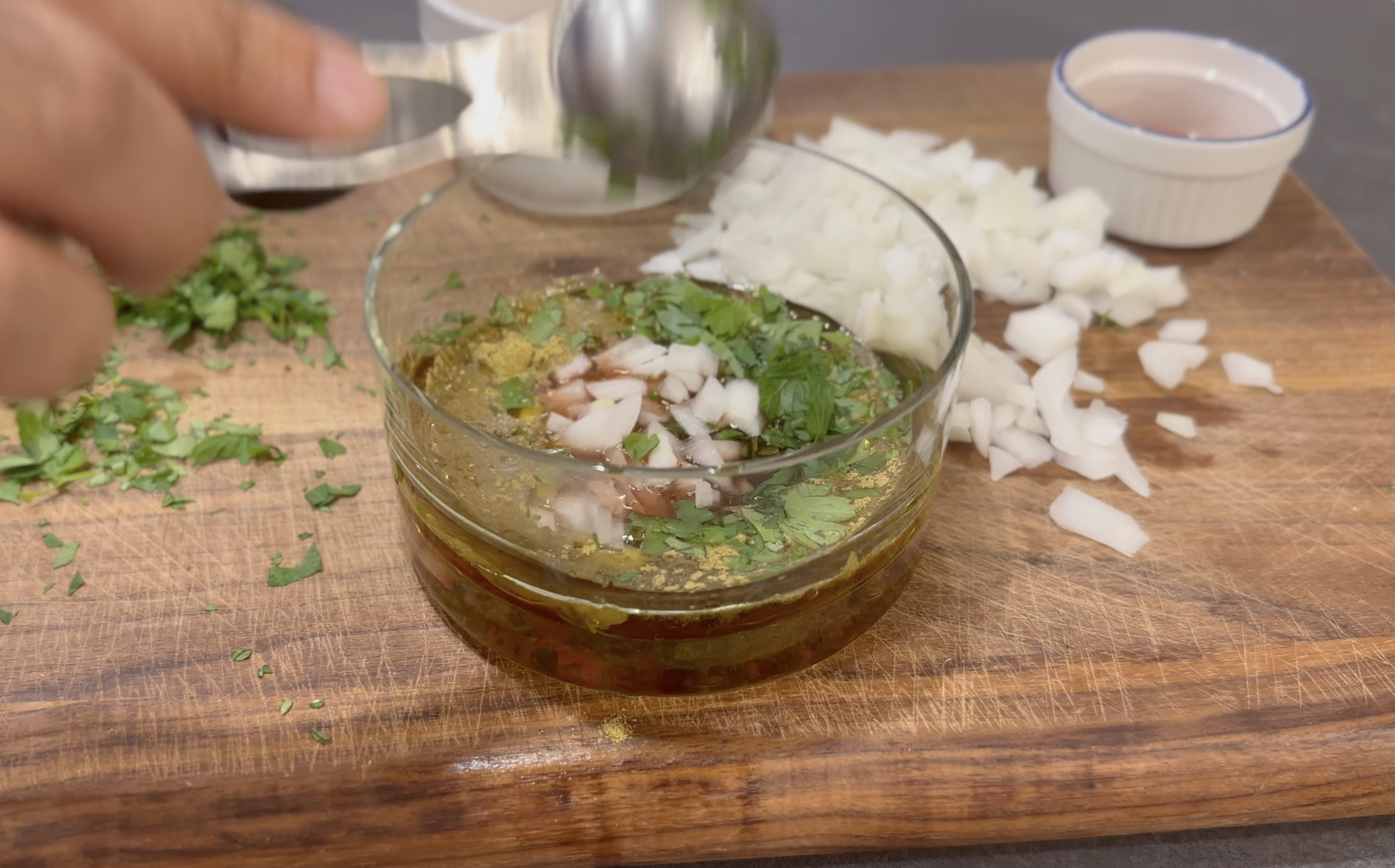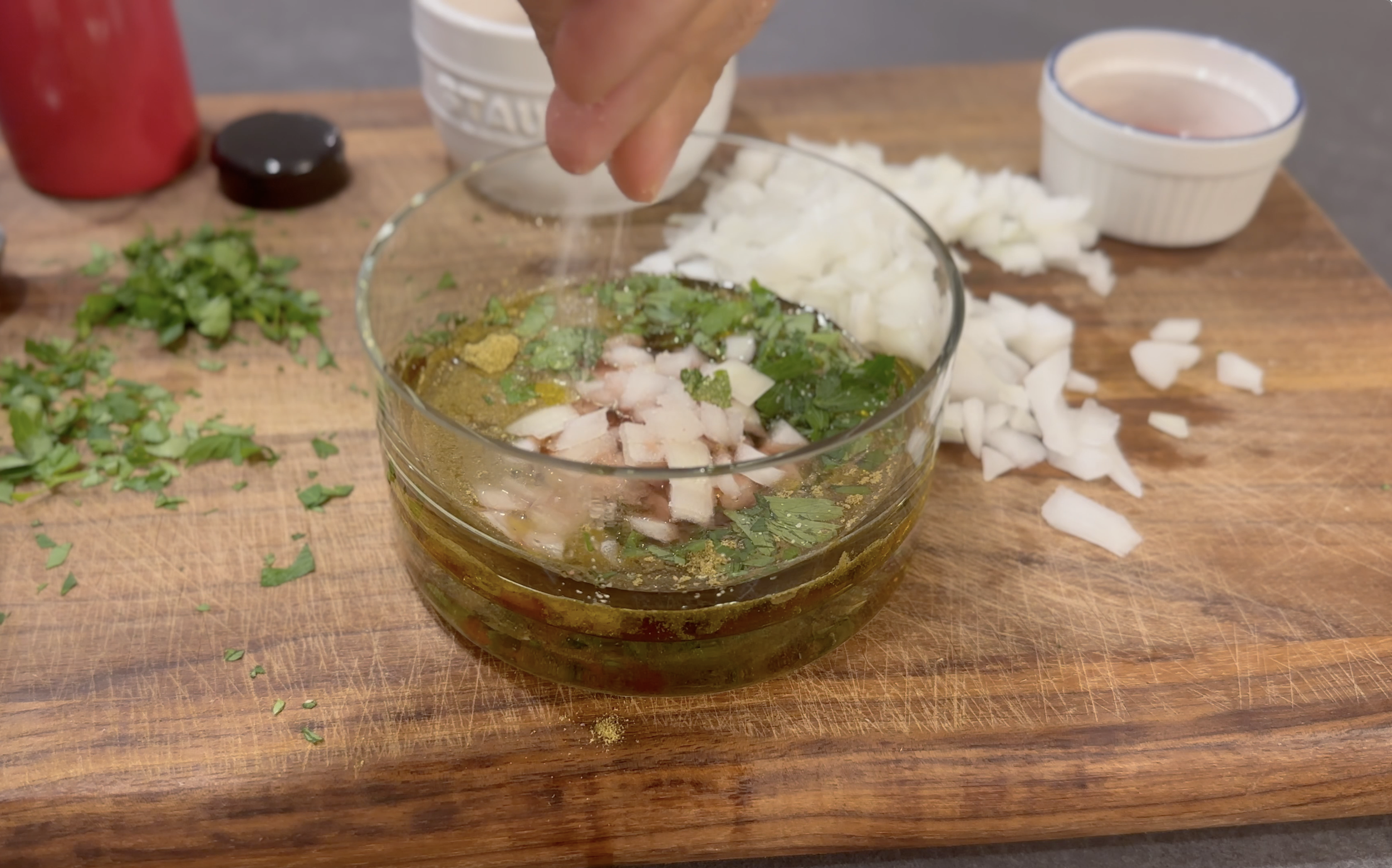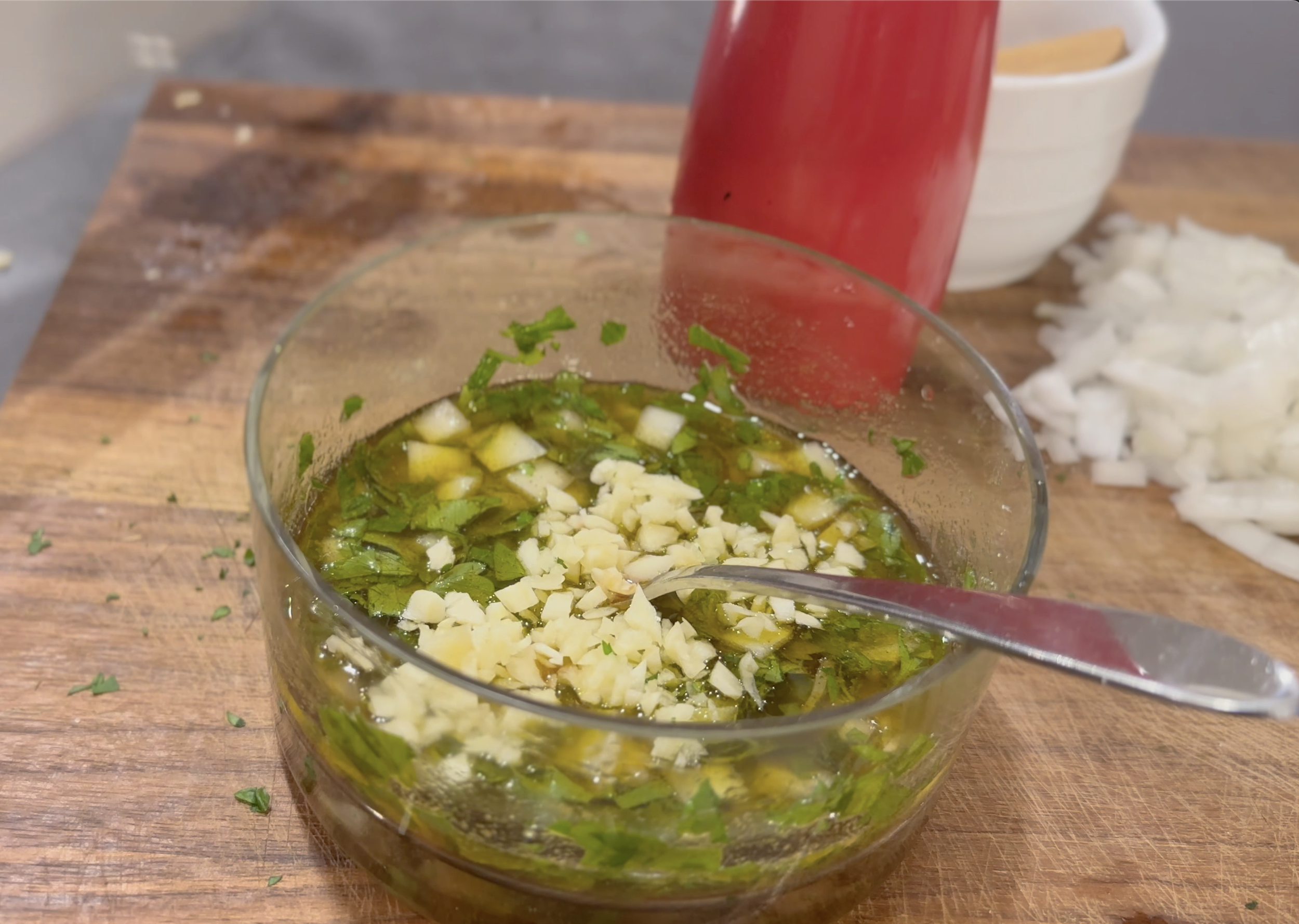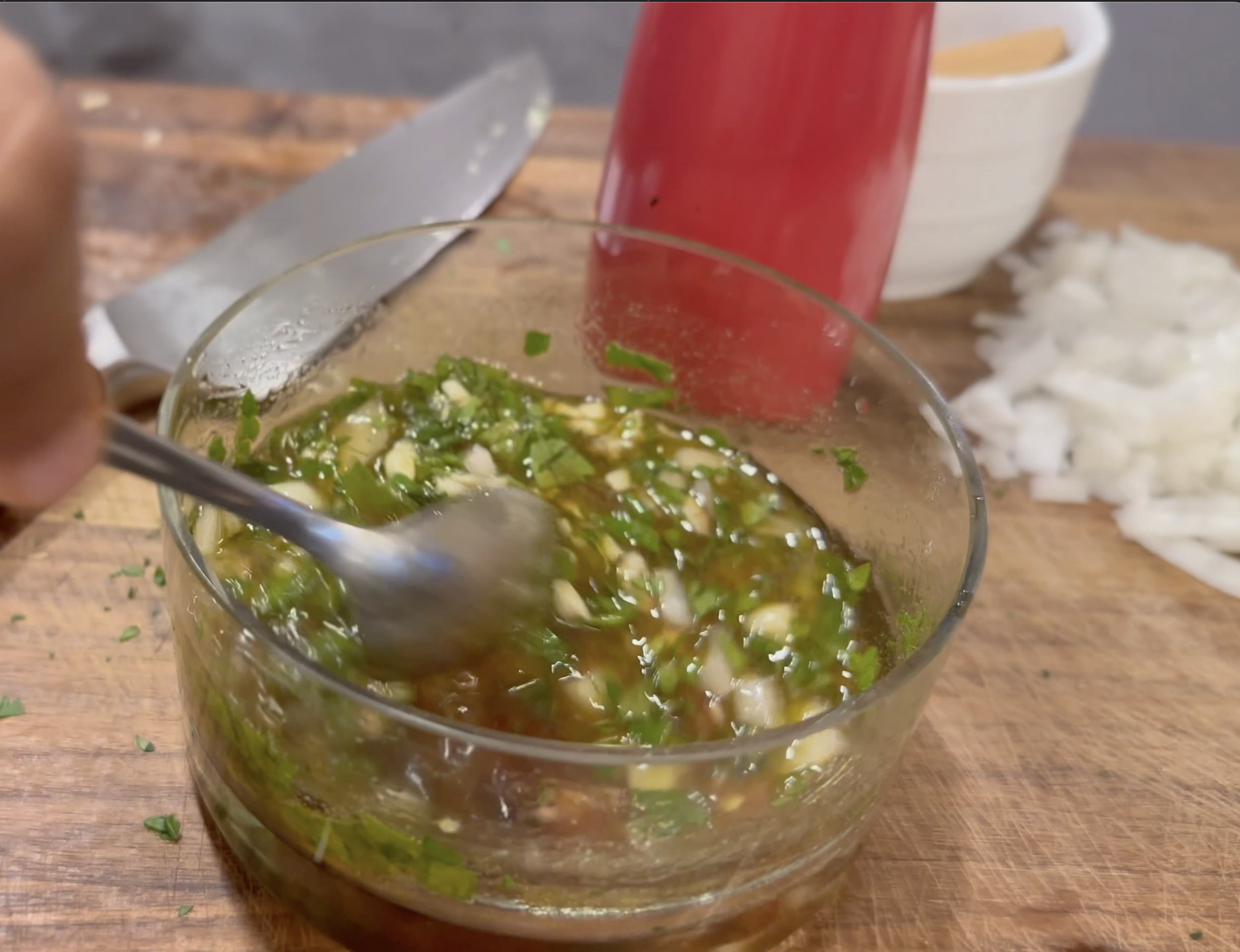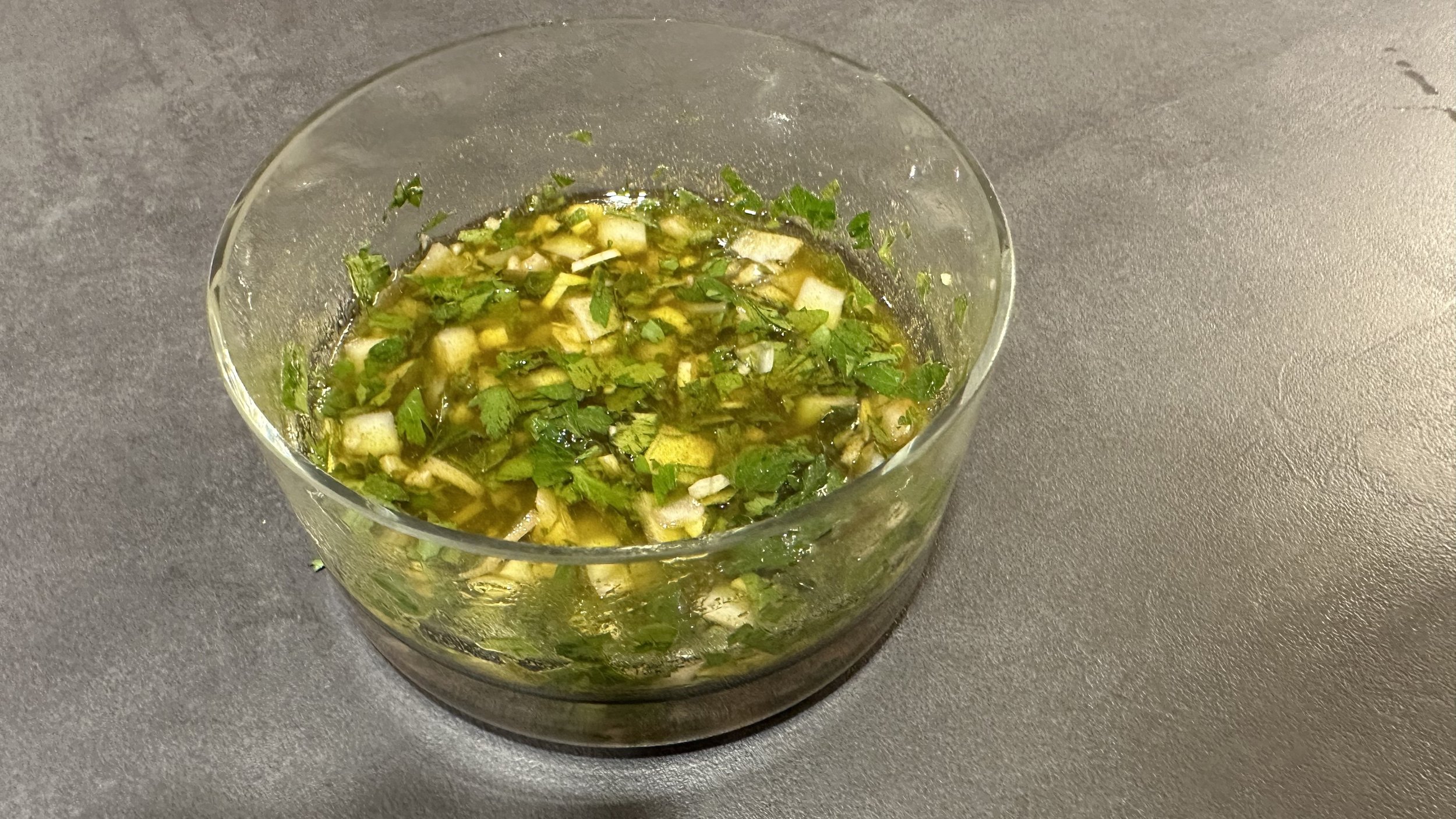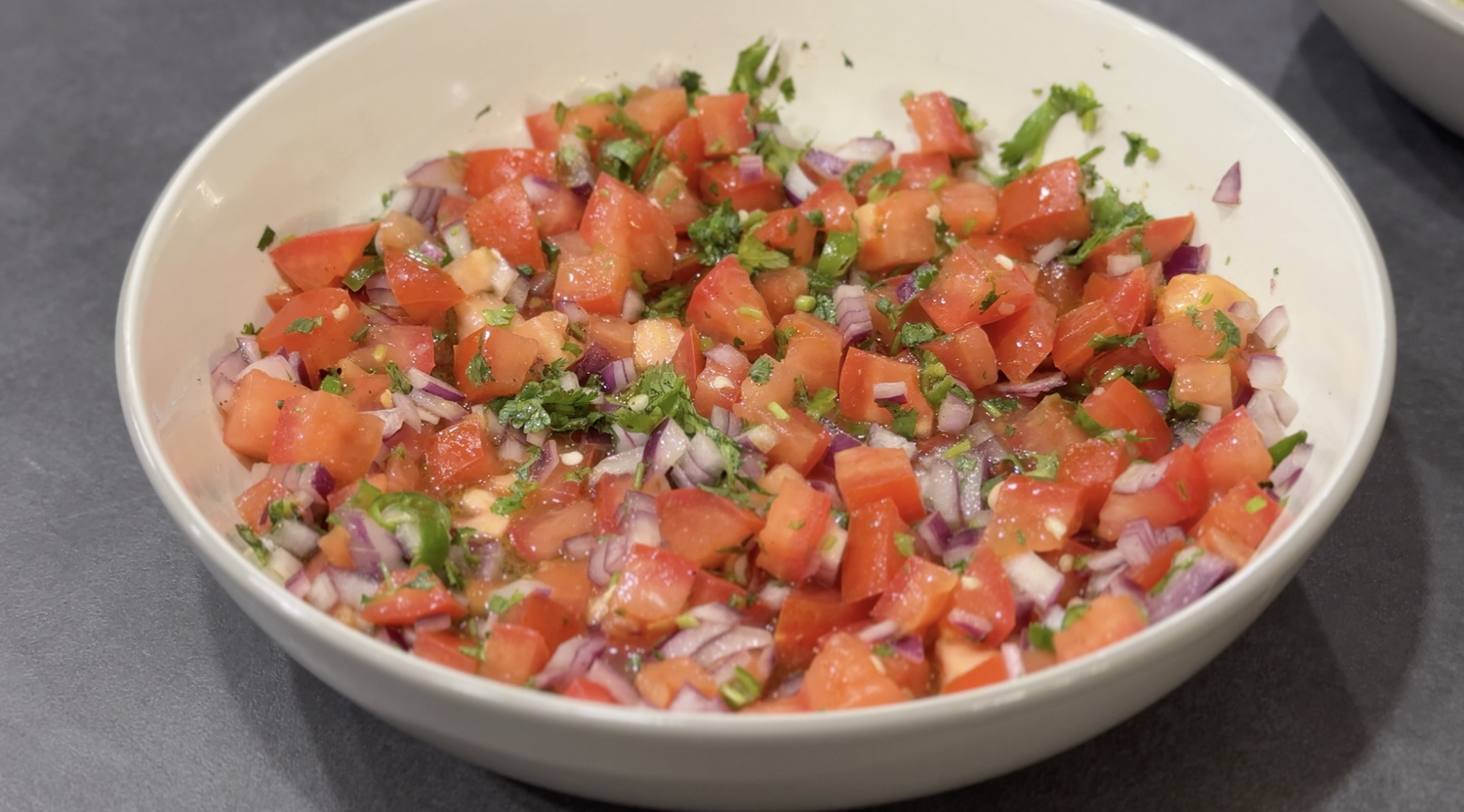Fresh & Quick Chimichurri Verde
This post may contain affiliate links. Read our disclosure policy
Looking for the fastest sauce that’s multipurpose and full of flavour? This Fresh and Quick Chimichurri Verde is key to perfecting grilled steaks, chicken, fish, or even to serve with veggies or on bread!
Want to have incredibly tender and flavourful meat or add a refreshing sauce to your sandwiches? This Fresh and Quick Chimichurri Verde is deceivingly simple for how tasty it is! You can honestly make it whenever you want, and as you’ll see later on in this post, you can use it in so many ways!
This chimichurri sauce recipe is an excellent base recipe. You’ll also see further on in this post how to build onto it based on what you’re in the mood for. If you’re new to Latin American cooking, then having this easy chimichurri sauce prepared can help take you on a trip to this destination unseen as part of your Live to Cook one-month challenge! You can get started on your cooking journey for free by signing up to my email newsletter, plus all of my new recipes on the blog will be sent directly to your inbox!
Check out the video at the bottom of this post to see how quickly this deliciously Fresh Chimichurri recipe comes together! Don’t forget to subscribe to my YouTube channel if you’re not already, and please hit the bell button to be notified when all of my new video recipes go live! Let’s get mixing!
What is ChimiChurri? Are Chimichurri and Pesto the same?
Chimichurri is a Latin-American green sauce originating from Argentina and Uruguay. While there is no concrete history behind the origins of chimichurri, the most popular story is that it was founded in the 19th century by an Irish immigrant in Argentina who was looking for Worcestershire sauce, which is also made with vinegar and garlic (in addition to molasses and anchovies!). As a result, he whipped up this concoction with the local ingredients! The name chimichurri took the name of this individual, named “Jimmy McCurry,” in the Argentinian pronunciation. Other stories involve hearing British invaders saying “Give the curry,” sounding like “chimichurri,” or Basque migrants bringing their herb sauce called tximitxurri.
Regardless of where the sauce comes from, Argentines adore their chimichurri, and this sauce is becoming popular across the West. Chimichurri is used both as a condiment and for marination of proteins. Chimichurri is often referred to as the Argentinian “pesto,” though they are actually quite different! While both are based with olive oil, garlic, and herbs, a classic pesto is basil-based, whereas the chimichurri is parsley-based. Furthermore, we add pine nuts and Parmesan cheese to pesto. In contrast, chimichurri is made by adding chopped onions and vinegar.
There are two versions of chimichurri sauce: the more popular green chimichurri (this one, also known as chimichurri verde) and a red chimichurri (chimichurri rojo). The red version still contains parsley, red wine vinegar, olive oil and garlic, but the base is also made with roasted red peppers and it is seasoned with smoked paprika to give the sauce its bold red colour.
Why You Should Make this Chimichurri Sauce Recipe
Minimal ingredients: This recipe only needs 5 ingredients! I’ve seen other recipes that use so many ingredients. While you can build on this recipe, I’ve provided a base that’s jam-packed with flavour and will get the job done! I’ll provide some variations if you want to get creative with your chimichurri, but trust me this simple recipe really goes a long way!
One-bowl recipe: You can mix all the ingredients in your little bowl if you’re making the default recipe. Easy to clean-up and so effortless!
Healthy: Everything is just so fresh and nutritious for you! The olive oil contains heart-healthy mono-unsaturated fat to reduce bad (HDL) cholesterol and will raise low (LDL) cholesterol. Furthermore, parsley is an excellent anti-inflammatory agent that can assist in reducing water retention!
Versatile: Check out all of my serving suggestion ideas later on in this post!
Dietary Information FOr Easy Chimichurri Sauce
This recipe is…
Gluten-free
Vegan
Dairy-free
Low-carb
Keto-friendly
What Does Chimichurri Taste like?
It’s a little to describe what chimichurri tastes like, but I find it quite pickly due to the vinegar! It’s tangy and herby with a slight hint of garlic. The onions add a nice chunkiness and a little bit of sharpness to the chimichurri.
Is Chimichurri hot or Spicy?
No not at all. I’m not adding any elements of heat to this recipe that would make this recipe spicy. I’ll describe a variation on how to add heat later on in the post!
Why is my Chimichurri Bitter?
This can be for a number of reasons:
The parsley is old: Fresher parsley will be less bitter, so make sure you’re using the freshest parsley possible.
The olive oil is old: This can also affect the bitterness of your chimichurri.
Too much garlic: If you’re not a big fan of garlic, then too much of it will cause the chimichurri to be bitter!
Over-mixing: This is more likely to happen if you’re mixing the ingredients in a blender. Blending the oil too much will result in a bitter final product.
Tools Needed to Make Quick Chimichurri
Ingredients for The Best Chimichurri
You can see all ingredient quantities and save the recipe for later by scrolling to the bottom of this post for the FULL PRINTABLE RECIPE CARD. By default, this Chimichurri Sauce recipe will yield one cup, but the recipe card will allow you to scale it based on how much you want to make!
Onion: You can use your favourite onion. I like both white and red onion, but in this recipe I’ve used white onion. The type of onion you use will slightly alter the flavour. If it’s your favourite onion, however, then I’m sure you’ll enjoy it!
Italian parsley: Also known as flat-leaf parsley. Make sure it’s not too dark to avoid a bitter chimichurri.
Garlic-Infused Oil: You can use a store-bought one or make it yourself. I like garlic-infused oil because you get a wonderful garlic taste in your oil. If you don’t want to use it, then simply use olive oil and chop some fresh garlic cloves. You will add your chopped garlic after first stirring the other ingredients.
Oregano: The authentic choice to season your chimichurri is dried oregano. However, I used ground oregano in this case, and it did the job just fine. If you really want to, you can use fresh oregano leaves. Keep in mind that for every teaspoon of ground oregano, you’ll want one tablespoon of fresh.
Red wine vinegar: If you don’t have this, you can use white vinegar or rice vinegar.
salt: My personal preference is to use Himalayan Pink Salt because it has less sodium and gives you more control when seasoning your food.
How to Make Argentinian Salsa Criolla
If using garlic oil, add together salt, garlic oil, red wine vinegar, and parsley in a bowl.
Mix well.
If using olive oil and chopped garlic, add your garlic after adding the other ingredients.
Use as a marinade or to top proteins or other dishes!
Can I Use a Blender?
Authentically you do NOT use a blender to make chimichurri! To be honest there’s no need to! I’ve seen recipes where people throw all the ingredients in the blender simply out of convenience. However, it only takes a couple of minutes to chop up the onions and parsley, so in my opinion I think you should stick to the hand-mixing method.
I also understand that you may not like the chunky sauce and may prefer a smooth sauce. In this case, you could use a blender to make the sauce smooth, but then it is not quite a real Argentinian chimichurri sauce.
Do I need to Refrigerate Chimichurri before using?
Technically this is a recipe where you don’t HAVE to refrigerate the sauce before using, and you can use it immediately. However, the chimichurri definitely does taste better the longer it sits because all of the wonderful flavours release. It’s up to you what you want to do. If you have the time to make it in advance before using it, then go ahead!
Ways to Use Chimichurri
In Argentina and Latin America, Chimichurri is used as a marinade and sauce for steaks. However, you don’t need to limit yourself to just that! Everyone can enjoy chimichurri, and you’ll likely have a lot leftover, so great creative with how to use it! As I describe in my free motivational guide to spark your creativity in the kitchen, Making Cooking Fun!!, using what you have on hand can give you plenty of ideas! Here’s only a small glimpse into the world of possibilities to use your chimichurri sauce:
In sandwiches & wraps, such as Quick & Easy Grilled Chicken Sandwich or to spruce up a Grilled Cheese Sandwich.
Level up your breakfast sandwich, such as a Sausage McMuffin or Breakfast BELT Bagel Bagel Sandwich.
Churrasco Beef Skewers are a staple recipe featuring chimichurri!
To spread in burgers, like my Spinach Turkey Burgers or even make a fusion burger by adding it to my McDonald’s India McAloo Tikki Burger.
A marinade and/or sauce for all sorts of protein, including poultry, beef, or fish & seafood. Just a couple of ideas include Italian-Herb Grilled Chicken, Pan-Seared Blackened Salmon, or even throw it into my Savoury Beef and Vegetable Couscous Bowl!
On eggs, particularly paired with some Poached Eggs or on top of your Fluffy Classic French Omelette.
Toss into a Potato Salad for a nice kick!
With rice, such as a perfect way to enhance simple Steamed White Rice.
On top of pizza, such as a BBQ Chicken Naan Pizza.
Variations of Chimichurri
Spicy: To make chimichurri spicy, add some red chili flakes.
Fresh herbs: You can also use a combination of cilantro and parsley. Experiment with your favourite ratio of the herbs.
Garlicky: Based on how strong of a garlic flavour you like, you can add more or less garlic cloves.
Low FODMAP: Ensure you’re using a garlic-infused oil where all the garlic has been strained out and omit the onions.
Acidity: If you want a little more tang to the chimichurri, try adding in some lemon juice or lime juice!
How to Store Chimichurri Verde
It’s easy to store your chimichurri sauce! Simply transfer the contents into an airtight container or in a mason jar. You can easily spoon out the desired portion when you’re ready to use it!
Because garlic can cause botulism, I would recommend you don’t keep your chimichurri in the fridge for longer than 5 to 7 days. If you’re using the garlic-infused oil without garlic pieces, you can stretch this out closer to 7 days. However, I would be more cautious if you’re using freshly minced garlic.
Can I freeze Chimichurri?
Technically you could. I recommend you do this by storing the chimichurri into an ice-cube tray. Then, you can defrost the portion you need before cooking.
You could also freeze the chimichurri sauce flat in a ziploc bag, then cutting it into little circles for the desired portion.
Other Super Fast condiments
WATCH HOW TO MAKE Fresh and Quick Chimichurri sauce HERE:
Let me know what you think of this recipe in the comments! If you’ve tried this recipe, be sure to post it on social media and tag it with #cookingwithanadi and mention me @cookingwithanadi. Thank you!

Fresh Quick Chimichurri Sauce
Ingredients
- 4 Tbsp red wine vinegar
- 4 Tbsp Garlic-Infused Oil or olive oil + minced garlic
- 1 tsp ground or dried oregano
- 2 Tbsp onions, finely chopped
- 2 Tbsp parsley, finely chopped
- salt, to taste
Instructions
- If using garlic oil, add together salt, garlic oil, red wine vinegar, and parsley in a bowl.
- Mix well.
- If using olive oil and chopped garlic, add your garlic after adding the other ingredients.
- Use as a marinade or to top proteins or other dishes!
Notes
Store leftovers in an airtight container or mason jar. Argentinian Salsa Criolla will stay fresh in the fridge for 5-7 days.
Nutrition Facts
Calories
48.89Fat (grams)
0.15 gSat. Fat (grams)
0.03 gCarbs (grams)
9.76 gFiber (grams)
3.37 gNet carbs
6.39 gSugar (grams)
0.81 gProtein (grams)
2.88 gSodium (milligrams)
360.75 mgCholesterol (grams)
0 mgFollow me
Meet Anadi
Welcome to Cooking With Anadi. This platform is all about making cooking exciting and finding new ways to bring classic flavours and recipes at your service. Join me in my personal journey in the world of cooking. Hope you have a great ride!

